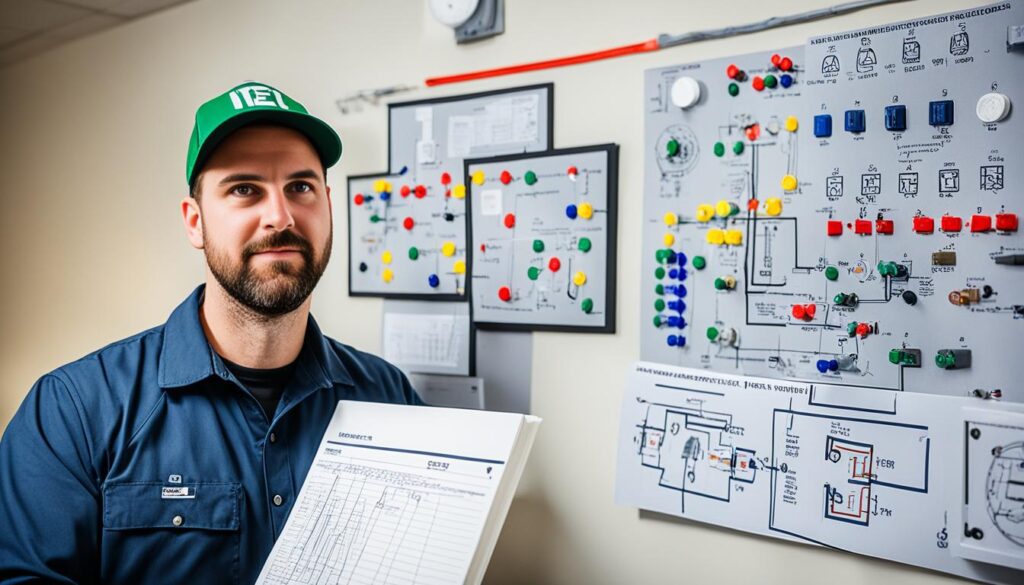What is the National Electrical Code (NEC) in Electrical Engineering?
The National Electrical Code (NEC) sets the standards for safe electrical engineering in the U.S. It’s published by the National Fire Protection Association (NFPA). This code aims to reduce risks like fires, electric shocks, and harm to people and places.
It creates a base for safe electrical systems in homes, offices, and schools. By doing this, it lets us use electricity safely. The NEC changes as technology does, staying up-to-date with the latest in electrical engineering safety.

Key Takeaways
- The NEC is the national standard for electrical safety in the United States, providing guidelines for safe design, installation, and inspection.
- The NEC is updated and published every three years, with the most recent edition being the 2023 version.1
- The NEC covers a wide range of topics, including circuit design, power systems, control systems, semiconductor devices, signal processing, electrical safety, renewable energy, and industrial automation.
- Compliance with the NEC is essential for electrical engineers to ensure the safety and efficiency of electrical systems.
- The NEC is a living document, continuously updated to incorporate the latest advancements in technology and safety.
Understanding the National Electrical Code (NEC)
The National Electrical Code (NEC) is always updating to include the newest in electrical engineering and electrical safety.2 Every three years, changes occur. These updates keep up with new rules for regulation of electrical installations, cabling and accessories, switching and protection devices, and earthing systems.
Evolving Safety Codified
In 2014, the NEC’s groups reviewed 3,745 suggestions and 1,625 comments from the public to improve electrical safety.2 Their hard work ensures the latest in safety practices are in the NEC, helping electrical engineers keep everyone safe.
A Responsive Process to Maximize Safety
The NEC updates every three years to keep its info fresh and useful in the ever-changing electrical engineering and electrical safety world.2 It stays current by adding new tech, addressing new hazards, and giving electrical engineers the info they need for safe electrical work.
The Safety Process
The NEC’s strength comes from its open development.2 It involves experts, feedback from the public, and detailed checks. This ensures electrical engineers have a safety-first guide for their work with regulation of electrical installations, cabling and accessories, switching and protection devices, and earthing systems.
Lifesaving Innovations Driven by the NEC
The National Electrical Code (NEC) plays a key role in making life safer with electrical safety inventions. An example is the Tamper Resistant Receptacles (TRRs). These became a must in the 2008 NEC edition for new homes.3 They have a special part inside that stops children from putting things into them, keeping kids safer from electric injuries.
Tamper Resistant Receptacles (TRRs)
TRRs are very important in modern electrical safety. They need pressure on both sides at the same time to open. This stops kids from putting things in them and getting hurt from electricity.
Arc-Fault Circuit Interrupters (AFCIs)
AFCIs are another big improvement because of the NEC. They find faults that could start fires and stop them before they can. Electrical engineers use them to make circuit design safer for homes and businesses.
Ground-Fault Circuit Interrupters (GFCIs)
The NEC also requires Ground-Fault Circuit Interrupters (GFCIs). They turn off power instantly when they sense a dangerous ground fault. This is super important for areas with moisture like kitchens and bathrooms. Electrical engineers depend on GFCIs to make their plans very safe.

The NEC and the Electrical Engineer
Understanding the National Electrical Code (NEC) is key for electrical engineers. It helps them with designing, installing, and inspecting electrical systems. The NEC sets standards for wiring practices, and how electrical installations should be regulated and protected. These rules change depending on the location.4
Wiring practice by region or country
The NEC creates the least amount of safe wiring standards. These may vary from place to place. It’s vital for engineers to know the NEC’s specific rules where they work. This ensures the safety of their electrical projects.4
Regulation of electrical installations
The NEC is a guide for setting up electrical systems. It shows how to get permits and pass inspections. Engineers must know the NEC well to make sure their work meets all rules and gets approved.4
Cabling and accessories
The NEC details every requirement for cables and parts. This includes things like conduits and junction boxes. Engineers should always be aware of the NEC’s updates. It helps keep electrical systems safe and running smoothly.4
Switching and protection devices
The NEC also sets the bar for safety devices, like circuit breakers and GFCIs. Engineers need to pick the right ones and set them up correctly. This is crucial for preventing electrical accidents.4
Earthing systems
Earthing systems are a must to prevent electrical shocks. The NEC shows how to do this properly. Engineers have to make sure their designs follow these guidelines. It makes installations safer and more reliable.4
Mastering the NEC is vital for electrical engineers. It guarantees that their work meets top safety standards. This protects people and buildings.5

| Key Statistical Highlights | Reference |
| Softcover book with 174 pages authored by H. Brooke Stauffer from the National Electrical Contractors Association (NECA). | 4 |
| Unit 7 of the book discusses the consensus process for developing the NEC and other NFPA documents. | 4 |
| Key features of the book include providing an overview of how the NEC functions in designing electrical systems, discussing safety rationales behind Code rules, explaining NEC usage for regulatory purposes, and covering its role in designing electrical distributed systems for buildings. | 4 |
| The book is based on the 2008 revisions to the NEC. | 4 |
| Author H. Brooke Stauffer is a member of IEEE, NFPA, and IAEI, serving on three different code-making panels and the ANSI Board of Standards Review. | 4 |
| Most electrical engineers do not work in power distribution, so many may not be knowledgeable about NEC issues in that specific area (e.g., power distribution). | 5 |
| In some states such as New Jersey, an electrical engineer can obtain an electrician’s license with criteria like an accredited EE degree, relevant experience, and passing a state exam. | 5 |
| Engineers specializing in niche areas like Programmable controllers might lack knowledge of broader electrical systems or NEC regulations outside their specialization. | 5 |
The Vital Role and Growing Demand for Electrical Engineers in a Rapidly Advancing Technological World
The National Electrical Code (NEC) sets the safety standard for all electrical work in the U.S.6 It is crucial for electrical engineers to know these rules. They help keep people and buildings safe.7
The field of electrical engineering is growing fast and will be worth $1.2 trillion by 2022.6 This is because technology is advancing quickly. We see these changes in power, phones, computers, and more.6
Electrical engineers play a big part in many industries. They help make power plants, phones, cars, and robots.6 Their work makes healthcare better, improves how we talk, move, and use energy, and boosts new tech.6 As tech needs grow, so does the role of electrical engineers.6
The NEC updates its rules every three years to stay current.7 Jobs for electrical engineers are expected to grow by 5% from 2019 to 2029. They make around $101,250 a year on average, and some earn more than $155,880.7 There’s a big need for them in green energy, smart grids, and making electric cars.7
FAQ
What is the National Electrical Code (NEC)?
The National Electrical Code (NEC) is a safety guide for electrical work in the U.S. It aims to keep people and places safe from electrical dangers. It’s set by the National Fire Protection Association (NFPA). The NEC helps prevent things like fires, shocks, and injuries.
How often is the National Electrical Code (NEC) updated?
Every three years, the National Electrical Code (NEC) gets an update. This update includes new tech and safer ways to work with electricity. In 2014, over 3,700 ideas for changes were discussed, along with 1,600 comments from the public. This ensures the NEC keeps up with the latest in safety.
What are some examples of lifesaving innovations driven by the NEC?
The NEC has pushed for many life-saving changes in electrical safety. One key example is the 2008 requirement for Tamper Resistant Receptacles (TRRs) in new homes. TRRs have a special cover inside. It lets plugs in but stops kids from putting things like keys into the outlet. It prevents serious accidents.
How does the NEC impact the work of electrical engineers?
For electrical engineers, knowing the NEC is key. It helps them understand how to wire safely, use the right tools, and protect systems. The code gives specific rules for each part of their work, which can change based on where they are working.
Source Links
- https://en.wikipedia.org/wiki/National_Electrical_Code
- https://www.mikeholt.com/understanding-the-nec.php
- https://www.csemag.com/articles/hospital-emergency-power-supply-systems/
- https://www.licensedelectrician.com/Store/JB/Engineers_Gde2NEC.htm
- https://www.electrical-contractor.net/forums/ubbthreads.php/topics/21856/do-all-electrical-engineers-understand-the-nec.html
- https://aimst.edu.my/event-news/how-electrical-engineering-impact-world/
- https://www.oxbridgeacademy.edu.za/blog/a-look-into-the-world-of-electrical-engineering/